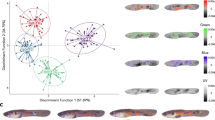Abstract
RECENT comparative studies of fibre–type arrays, mostly in the New Zealand Romney, have thrown new light on the probable course of evolution in the coat of the sheep from wild type to the most ‘improved’ domesticated fleece. Fibre type arrays1 are distinguished essentially by differences attributed to the lesser or greater power of the pre–natal check. The effect of this check stands out most clearly when, as in Ravine and Valley arrays, among fibres beginning their development before birth, it causes some starting to grow earlier to be finer than some starting to grow later. Fibre–type array is strongly inherited2 and this fact gives confidence in the soundness of this new approach to the evolution of the fleece.
This is a preview of subscription content, access via your institution
Access options
Subscribe to this journal
Receive 51 print issues and online access
$199.00 per year
only $3.90 per issue
Buy this article
- Purchase on Springer Link
- Instant access to full article PDF
Prices may be subject to local taxes which are calculated during checkout
Similar content being viewed by others
References
N. Z. J. Agric., 48, 6 (1934).
N. Z. J. Sci. Tech., 22, 4A (1940).
Emp. J. Exp. Agric., 4 (1936).
Sutherland, J. A., Unpublished thesis, University of New Zealand (1939).
J. Text. Inst., 28, 12 (1937).
Author information
Authors and Affiliations
Rights and permissions
About this article
Cite this article
GOOT, H. Evolution of the Fleece of the Sheep. Nature 148, 596–597 (1941). https://doi.org/10.1038/148596b0
Issue Date:
DOI: https://doi.org/10.1038/148596b0
This article is cited by
Comments
By submitting a comment you agree to abide by our Terms and Community Guidelines. If you find something abusive or that does not comply with our terms or guidelines please flag it as inappropriate.



